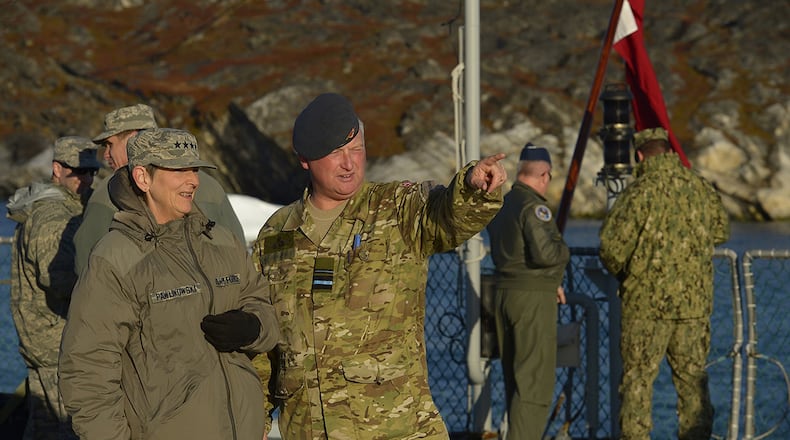Beginning with stops at Eielson Air Force Base, Clear Air Station and Long Range Radar Site Point Barrow, Alaska, the expedition members were given firsthand knowledge about what it takes operate in the coldest climates in the United States.
Departing the U.S., the first international stop on the expedition was Thule Air Base, Greenland, for discussion on strategic geography, international treaties and a mission brief from the 821st Air Base Group.
After stops at missile warning, missile defense and space situational awareness radar sites, the group headed north and landed on an icy runway just 55 miles from the North Pole at Canadian Forces Station Alert.
“When you step off the plane in Alert, Canada, you quickly realize you’re about as far away as you can be from other humans without leaving the planet,” said Col. Robert Novotny, Air Combat Command deputy director of plans and programs. “It’s like being stranded on a remote desert island – except the frigid temperatures and ice are trying to kill you.”
The stop in Alert wasn’t just to put these general officers on a frozen tundra that seemed like endless ice fields in each direction, though.
“We are here because we, as an Air Force, must strengthen partnerships with our Arctic allies and develop operational proficiency in some of the toughest climates,” said Lt. Gen. Mark Nowland, Air Force deputy chief of staff for operations. “We are an Arctic nation, and we need to know as much about the Arctic as we can to ensure it remains stable and free of conflict.”
After touring the Canadian-run station, the group boarded their Royal Canadian Defence Force C-17 for Thule AB before heading south to Illulissat, Greenland, to meet with Armed Forces Denmark’s Joint Arctic Command.
“(When) you hear you are meeting with the Danish Armed Forces, you expect to meet with a professional military force that knows how to operate in the coldest places,” said Gen. Ellen Pawlikowski, commander of Air Force Material Command. “What we didn’t expect was to be put on a helicopter and flown onto a glacier.”
The members of the expedition boarded a helicopter and flew 45 miles from the western coast of the largest island on the planet and dropped off on top of a glacier that is more than 110 miles long. The glacier trip was important to see just how daunting the task of search and rescue can be in the most remote locations.
“It was an honor to host the Air Force and show them where we conduct search and rescue missions, how we operate in temperatures that often drop below -50 degrees Fahrenheit and discuss how we can work together to protect the Arctic,” said Maj. Gen. Kim Jesper Jorgensen, Joint Arctic Command commander. “We need to work on our operational cooperation and by (them) coming here and taking an interest in how we operate, I am confident this partnership will ensure the safety of the Arctic for years to come.”
About the Author
